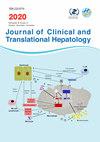Update on the Diagnosis and Treatment of Combined Hepatocellular Cholangiocarcinoma
IF 3.1
3区 医学
Q2 GASTROENTEROLOGY & HEPATOLOGY
引用次数: 0
Abstract
Combined hepatocellular-cholangiocarcinoma (cHCC-CCA) is a unique type of liver tumor that contains both hepatocellular carcinoma and cholangiocarcinoma components within a single tumor. The fifth edition of the World Health Organization classification provides a definition and diagnostic criteria for cHCC-CCA. However, the heterogeneous histomorphology and presentation resulting from variation of the proportion of each component poses challenges for clinical diagnosis and treatment. A diagnosis of cHCC-CCA may be suggested by the synchronous elevation of serum tumor markers for hepatocellular carcinoma and cholangiocarcinoma, a mixed enhancement pattern on imaging, and a discrepancy between the elevation of tumor marker and the imaging enhancement pattern. Histopathological examination using hematoxylin and eosin staining is considered the gold standard for diagnosing cHCC-CCA, and comprehensive examination of resection or biopsy specimens is crucial for an accurate diagnosis. Currently, there is no standard treatment for cHCC-CCA, and surgery is the mainstay. Anatomic hepatectomy with lymphadenectomy is among the recommended surgical procedures. The role of liver transplantation in the management of cHCC-CCA is still uncertain. Transarterial chemoembolization may be effective for unresectable cHCC-CCA, particularly for hypervascular tumors. However, the available evidence does not support systemic therapy for advanced cHCC-CCA. The prognosis of cHCC-CCA is generally poor, and there is no established staging system. Further research is needed to better understand the histogenesis and clinical management of cHCC-CCA. This review provides an overview of the current literature on cHCC-CCA with a focus on its clinical characteristics, pathological diagnosis, and management.肝细胞合并胆管癌的诊断和治疗进展
合并肝细胞胆管癌(cHCC-CCA)是一种独特的肝脏肿瘤类型,在单个肿瘤中包含肝细胞癌和胆管癌成分。世界卫生组织第五版分类提供了cHCC-CCA的定义和诊断标准。然而,由于各成分比例的变化导致的异质组织形态和表现给临床诊断和治疗带来了挑战。肝细胞癌和胆管癌血清肿瘤标志物同步升高,影像学呈现混合增强模式,肿瘤标志物升高与影像学增强模式不一致,提示cHCC-CCA的诊断。苏木精和伊红染色的组织病理学检查被认为是诊断cHCC-CCA的金标准,对切除或活检标本进行全面检查对于准确诊断至关重要。目前,cHCC-CCA没有标准的治疗方法,以手术为主。解剖性肝切除术加淋巴结切除术是推荐的手术方法之一。肝移植在cHCC-CCA治疗中的作用仍不确定。经动脉化疗栓塞可能对不可切除的cHCC-CCA有效,特别是对高血管肿瘤。然而,现有证据不支持对晚期cHCC-CCA进行全身治疗。cHCC-CCA预后一般较差,且无明确的分期体系。为了更好地了解cHCC-CCA的组织发生和临床治疗,需要进一步的研究。本文综述了目前关于cHCC-CCA的文献,重点介绍了其临床特征、病理诊断和治疗。
本文章由计算机程序翻译,如有差异,请以英文原文为准。
求助全文
约1分钟内获得全文
求助全文
来源期刊

Journal of Clinical and Translational Hepatology
GASTROENTEROLOGY & HEPATOLOGY-
CiteScore
6.40
自引率
2.80%
发文量
496
 求助内容:
求助内容: 应助结果提醒方式:
应助结果提醒方式:


